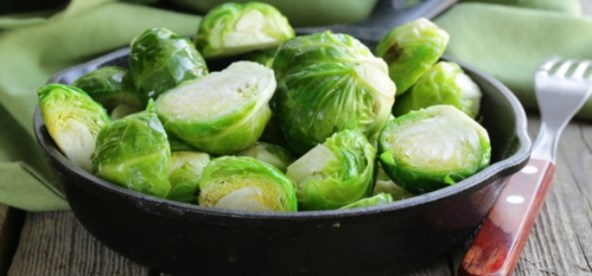
You might ask what Brussels sprouts and estrogens are doing in the same sentence, but I am here to tell you that there is a connection.
Brussels sprouts are the cruciferous connection to healthy hormone metabolism. These age-old options –including cabbage, broccoli, bok choy and cauliflower – have gained new acclaim today as dietary super foods. These plants, cultivated for centuries and originally used as medicines, can nourish us towards superior health and hormone balance.
Brussels Sprouts vs. Bad Estrogens
So how is it that the humble Brussels sprout and other crucifers are suddenly empowered with such healthy purpose? The answer boils down to biochemistry: when crucifers are added to one’s daily diet, their active ingredients, indole-3-carbinol (I3C) and 3,3'-diindolylmethane (DIM) affect estrogen metabolism and lead to favorable shifts in hormone markers which in turn may reduce the incidence of several types of cancer.
DIM, for example, works its magic by activating more efficient estrogen metabolism in the body, multiplying the chance for it to be broken down into healthy or “good” metabolites (a.k.a. the “2-hydroxy estrogens” for you science buffs) vs. the “bad” metabolites. These bad metabolites are responsible for estrogen’s many undesirable actions, such as heavy periods, weight gain, mood swings, depression, low thyroid symptoms, and greater risks for fibroids, endometriosis, breast, and uterine cancers.
The Pathway to Good Estrogens

Most of the benefits attributed to estrogen – protection of our breasts, skin, bones, blood vessels, heart and brain against the diseases of aging – are known to come from these good estrogens. So back to the Brussels sprout – not only does its active ingredient lead estrogen down the “good pathway,” it helps rid the body of unsafe hormone build up.
Accumulations of bad estrogens usually result from imbalances or exposure to xenoestrogens. The ‘xenos’ (meaning foreign or outside of ) are man-made environmental toxins completely unnatural to the human body. These hormone impostors do their worst by mimicking, or over-stimulating estrogen action in the target tissues of the body (breasts, skin, uterus). Otherwise known as endocrine disruptors, they are capable of wreaking havoc on normal hormone operating systems with notable health consequences.
Where do xenos come from? Let me count the ways:
- the pesticides we spray on our rosebuds
- the hormone-injected beef, chicken, and dairy on our plate (did you know that some milk products contain up to 11 different kinds of synthetic estrogens?)
- the face creams, makeup, and hair dyes we absorb into our pores
- the harsh household chemicals we wash, spray, wipe and flush away into the water supply
- the plastic containers we microwave in, soft plastic water bottles we drink from
- synthetic hormones and other drugs we inhale or swallow.
Collectively, these xenoestrogens go by the names of HRT, RBST, PCBs, PVCs, phthalates, laureth sulfates, benzene, xanthine and all those other names that get harder to pronounce as you read down the label.
How can we get rid of xenos and turn bad estrogens into good? By switching to:
- hormone-free protein sources (the label should read: raised without artificial growth hormones or antibiotics)
- bioidentical hormones that duplicate the body’s own (vs. synthetic HRT formulations consisting of estrogens derived from pregnant mares' urine and progestins, a toxic imposter of natural progesterone)
- eco-friendly, “green” household, gardening and personal care products
- glass or ceramic – never plastic – for microwaving, heating and storing foods
- drinking from stainless steel or BPA-free water bottles
- exercising in the open air (note: sweating rids the body of accumulated toxins)
- AND, to take us full circle, by eating plenty of cruciferous vegetables, baked, sauteed, or lightly steamed, to retain their natural fiber! Brussels sprouts with sea salt, with onions and garlic, with apple and bacon, and even curry and horseradish are now entrees for growing legions of health conscious consumers. (Anyone with a recipe for making cauliflower taste good? We’re all ears!)
You can also take DIM, the active ingredient in crucifers, available as a supplement in health food stores, compounding pharmacies or online. Feel free to add your own suggestions in the comments below.
Related Resources
